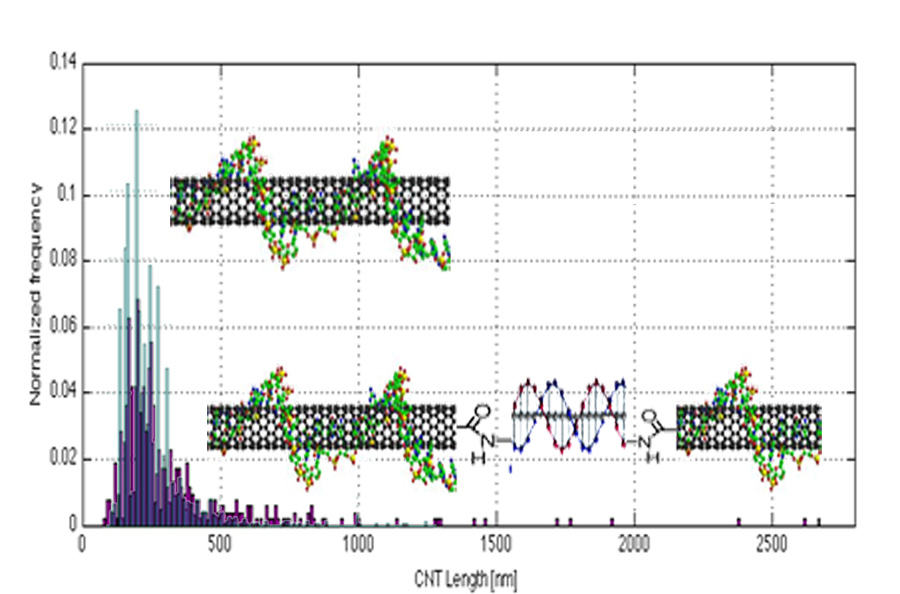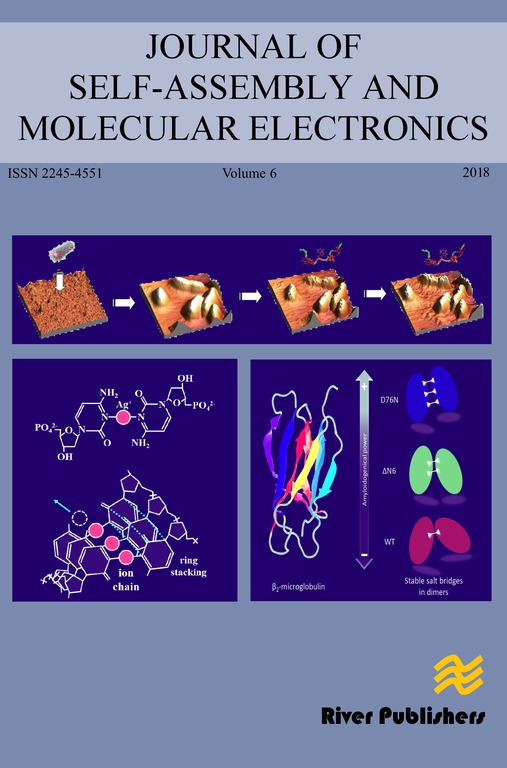Integrating DNA with Functional Nanomaterials
DOI:
https://doi.org/10.13052/jsame2245-4551.122Abstract
DNA may be the most versatile molecule discovered to date. Beyond its well-
known central role in genetics, DNA has the potential to be a remarkably useful
technological material. It has been demonstrated as a scaffold for the assembly
of organic and inorganic nanomaterials [1]; a vehicle for drug delivery [2]; a
medium for computation [3]; and a possible wire for transporting electrical
signals [4]. A key factor in exploiting DNA in these ways is the ability to
integrate DNA with other materials. In this paper, we review two approaches
to forming DNA complexes with functional nanomaterials: (1) linking DNA
with single-wall carbon nanotubes (SWCNTs), which can then be used as
nanoscale electrical contacts for probing electron transport in DNA; and (2)
directed nanoassembly of Au nanoparticles using DNA/PNA (peptide nucleic
acid) hybrid scaffolds.
Downloads
References
F. A. Aldaye, A. L. Palmer, and H. F. Sleiman, Assembling Materials with
DNA as the Guide, Science, 321(5897): 1795–1799 (2008).
J. Fu and H. Yan, Controlled drug release by a nanorobot, Nat Biotech,
(5): 407–408 (2012).
L. M. Adleman, Computing with DNA, Sci Am, 279(2): 54–61 (1998).
J. C. Genereux and J.K. Barton, Mechanisms for DNA Charge Transport,
Chem Rev, 110(3):1642–1662 (2010).
X. Guo, J. P. Small, J. E. Klare, Y. Wang, M. S. Purewal, I. W. Tam,
B. H. Hong, R. Caldwell, L. Huang, S. O’Brien, J. Yan, R. Breslow, S.
J. Wind, J. Hone, P. Kim, and C. Nuckolls, Covalently bridging-gaps
in single-walled carbon nanotubes with conducting molecules, Science,
(5759): 356–359 (2006.).
X. F. Guo, A. Whalley, J. E. Klare, L. M. Huang, S. O’Brien, M.
Steigerwald, and C. Nuckolls, Single-molecule devices as scaffolding
for multicomponent nanostructure assembly, Nano Lett,. 7(5):1119–1122
(2007).
X. F. Guo, A. A. Gorodetsky, J. Hone, J. K. Barton, and C. Nuckolls,
Conductivity of a single DNA duplex bridging a carbon nanotube gap.
Nature Nanotechnology, 3(3): 163–167 (2008).
Integrating DNA with Functional Nanomaterials 191
X. Y. Huang, R. S. McLean, and M. Zheng, High-resolution length sorting
and purification of DNA-wrapped carbon nanotubes by size-exclusion
chromatography, Anal Chem, 77(19): 6225–6228 (2005).
DNA strands were purchased from Syntezza.
Y. Weizmann, D. M. Chenoweth, and T. M. Swager, Addressable Termi-
nally Linked DNA-CNT Nanowires, J Am Chem Soc, 132(40):14009–
(2010).
T. Bentin and P. E. Nielsen, In vitro transcription of a torsionally
constrained template, Nucleic Acids Res, 30(3): 803–809 (2002).
P. E. Nielsen, M. Egholm, and O. Buchardt, Peptide Nucleic-Acid (PNA)
- a DNA Mimic with a Peptide Backbone, Bioconjugate Chem, 1994.
(1): p. 3–7.
P. E. Nielsen, A new molecule of life? Peptide nucleic acid, a synthetic
hybrid of protein and DNA, could form the basis of a new class of drugs-
and of artificial life unlike anything found in nature, Sci Am, 299(6):
–71 (2008).
P. E. Nielsen, M. Egholm, R. H. Berg, and O. Buchardt, Sequence
Specific-Inhibition of DNA Restriction Enzyme Cleavage by PNA,
Nucleic Acids Res, 1993. 21(2): 197–200.
P. S. Lukeman, A. C. Mittal, and N. C. Seeman, Two dimensional
PNA/DNA arrays: estimating the helicity of unusual nucleic acid
polymers, Chem Commun, (15): 1694–1695 (2004).
A. L. Stadler, D.Z. Sun, M. M. Maye, D. van der Lelie, and O. Gang,
Site-Selective Binding of Nanoparticles to Double-Stranded DNA via
Peptide Nucleic Acid "Invasion", ACS Nano, 5(4): 2467–2474 (2011).
Applied biosystems - support. https://www2.appliedbiosystems.com
/support/seqguide.cfm?
E. Y. Chan, N. M. Goncalves, R. A. Haeusler, A. J. Hatch, J. W. Larson,
A. M. Maletta, G. R. Yantz, E.D. Carstea, M. Fuchs, G.G. Wong, S.R.
Gullans, and R. Gilmanshin, DNA mapping using microfluidic stretching
and single-molecule detection of fluorescent site-specific tags, Genome
Res, 14(6): 1137–1146 (2004).
H. Zohar, C. L. Hetherington, C. Bustamante, and S. J. Muller, Peptide
Nucleic Acids as Tools for Single-Molecule Sequence Detection and
Manipulation, Nano Lett, 10(11): 4697–4701 (2010).
P. E. Nielsen, Peptide nucleic acids : methods and protocols. Methods in
molecular biology., Totowa, N. J.: Humana Press. 274 p (2002).
Integrated DNA Technologies, Coralville, IA
Shalom J. Wind et.al
M. Schvartzman and S.J. Wind, Robust Pattern Transfer of Nanoim-
printed Features for Sub-5-nm Fabrication. Nano Lett, 9(10): 3629–3634
(2009).
H. Namatsu, Y. Takahashi, K. Yamazaki, T. Yamaguchi, M. Nagase,
and K. Kurihara, Three-dimensional siloxane resist for the formation
of nanopatterns with minimum linewidth fluctuations, J Vac Sci Technol
B, 16(1): 69–76 (1998).
M. Palma, J. J.Abramson,A.A. Gorodetsky, E. Penzo, R. L. Gonzalez, M.
P. Sheetz, C. Nuckolls, J. Hone, and S. J. Wind, Selective Biomolecular
Nanoarrays for Parallel Single-Molecule Investigations, J Am Chem Soc,
(20): 7656–7659 (2011)




